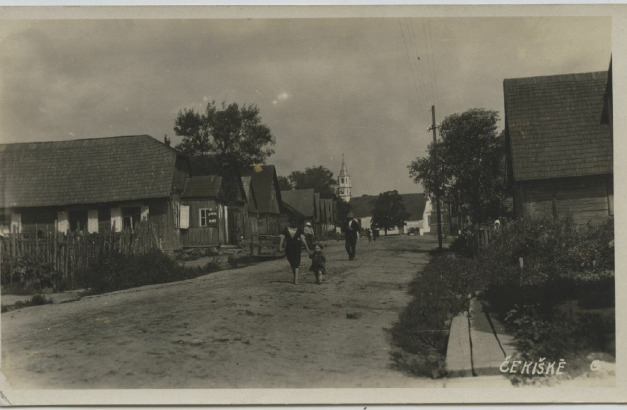Prie Dubysos upės ir Kaunas-Raseiniai kelio įsikūrusioje Čekiškėje nedidelė organizuota žydų bendruomenė susiformuoja greičiausia apie XVIII a. vidurį. Būtent tuomet gyvenvietė tampa miesteliu ir 1762 m. jai suteikta turgų ir prekymečio privilegija. Esamas ir ankstesnis pavienis paminėjimas - Vilkijos apylinkėse 1687 m. minimas žydas turėjęs užeigos namus Čekiškėje.
Nedidelė žydų bendruomenė 1765 m. jau turėjo medinę sinagogą, panašiu metu įsteigtos ir kapinės, mikva. Miestelis keletą kartų nukentėjo nuo gaisrų. Po 1887 m. kilusio gaisro sudegė didžioji dalis miestelio, iš viso net 66 namai (daugiausia žydų). Po gaisro, XIX a. pab. pastatyta dabartinė, iki šių dienų išlikusi, raudonų plytų mūro Čekiškės sinagoga. Nepaisant prastos pastato būklės, Čekiškės sinagoga ir jos interjeras yra laikomas vienu geriausiai išlikusių aron kodešo ir sinagogų sieninės tapybos bei dekoro pavyzdžių Lietuvoje.
Įvairiais istorijos laikotarpiais žydai sudarė daugiau nei pusę Čekiškės miestelio gyventojų. Žydai Čekiškėje vertėsi amatais, prekyba, nemaža dalis nuomavosi sodus bei užsiėmė vaisių auginimu ir prekyba. Čekiškėje žydai daugiausia telkėsi ir gyveno aplink pagrindinę turgaus aikštę, sinagogą. Veikė pradinė žydų mokykla, biblioteka, žydų bankas, vaistinė, apie 20 parduotuvių, 4 smuklės, ugniagesių draugija, futbolo komanda. Šolomui Vigderovui priklausė karšykla, Lipmanas ir Judeliauskas turėjo odų fabriką, Aizikas Finas užsiėmė javų prekyba (ir vienintelis Čekiškėje turėjo telefoną), Štreichmanui priklausė malūnas ir t.t. Tarpukariu Čekiškėje savo ateljė turėjo fotografas Leizeris Bekeris, kurio dėka užfiksuoti svarbiausi miestelio įvykiai. Čekiškės žydai savo laisvalaikį taip pat leisdavo pušynėlyje prie Dubysos.
Čekiškėje gimė rabinas ir talmudistas Mordechajus Elijašbergas (1817–1889), kuris prasidėjus sionistiniams judėjimui jį itin palaikė. Vienas labiausiai neįvertintų Lietuvos žydų istorikų taip pat siejamas su Čekiške. Nuo 1925 m. iki pat Holokausto Čekiškėje gyveno vaistininkas Dovydas Lipmanas (1888-1941), kuris buvo atsidavęs žydų istorijos tyrinėtojas, pirmasis Kauno ir Žemaitijos žydų istorijos autorius. D. Lipmanas buvo vienas iš Žydų Istorinės-Etnografinės draugijos Lietuvoje iniciatorių. Reguliariai rašė straipsnius žydų laikraščiams bei publikavo istorines apybraižas; buvo parengęs Žydų bendruomenių Lietuvoje istoriją (Gešikhte fun jidiše kehiles in Lite), tačiau dėl Holokausto jos neišleidęs. D. Lipmanas ir jo gyvenimo tyrinėjimai prarasti, o pats D. Lipmanas nužudytas kartu su kitais Čekiškės žydais. Pasak Čekiškės kraštotyrininko Antano Vaičiaus, Dovydą Lipmaną pakelės griovyje nušovė lietuviai baltaraiščiai iš Vilkijos.
1941 m. vasarą prasidėjo žydų naikinimas, dalis Čekiškės žydų perkelta į Vilkiją, vėliau į Kauną. Prieš pat Holokaustą miestelyje gyveno 60 žydų šeimų. Čekiškės su kitais apylinkių žydais nužudyti Jaučakių kaime šalia Vilkijos.
Čekiškė (Tsaykishok, צײַקישאָק)
In Čekiškė, located near the Dubysa River and the Kaunas-Raseiniai road, a small organised Jewish community was formed probably around the middle of the 18th century. It was then that the settlement became a town and was granted the privilege of markets and a market in 1762. There is also an earlier isolated mention of a Jew in the vicinity of Vilkija in 1687 who had an inn in Čekiškė.
A small Jewish community already had a wooden synagogue in 1765, and a cemetery and mikvah were established at the same time. The town suffered several fires. A fire in 1887 burnt down most of the town, as many as 66 houses (mostly Jewish). After the fire, the present red brick Chekiškės synagogue, which has survived to this day, was built at the end of the 19th century. Despite the poor condition of the building, the Chekiškės Synagogue and its interior is considered one of the best preserved examples of aron kodesh and synagogue wall paintings and decoration in Lithuania.
At various times in history, Jews made up more than half of the population of Čekiškės. Jews in Čekiškė were involved in crafts and trade, and many of them rented gardens and were involved in fruit growing and trading. The Jews in Čekiškė were mainly concentrated and lived around the main market square and synagogue. There was a Jewish primary school, a library, a Jewish bank, a pharmacy, about 20 shops, 4 taverns, a firefighters' association and a football team. Sholom Vigderov owned a carding plant, Lipman and Judeliauskas had a leather factory, Aizik Fin was a cereal merchant (and was the only one in Chekiškės with a telephone), Štreichman owned a mill, etc. In the interwar period, the photographer Leizer Beker had his own studio in Čekiškė, thanks to which the most important events in the town were captured. The Jews of Čekiškės also spent their leisure time in the pine grove by the Dubysa River.
Mordechai Eliashberg (1817-1889), a rabbi and Talmudist, was born in Chekiškis and was a strong supporter of the Zionist movement when it began. One of the most underrated historians of Lithuanian Jewry is also associated with Chekiškis. From 1925 until the Holocaust, the pharmacist Dovydas Lipmanas (1888-1941), who was a dedicated researcher of Jewish history and the first author of the history of the Jews of Kaunas and Samogitia, lived in Čekiškė. Lipman was one of the initiators of the Jewish Historical-Ethnographic Society in Lithuania. He regularly wrote articles for Jewish newspapers and published historical essays; he was the author of the History of the Jewish Communities in Lithuania (Gešikhte fun yidiše kehiles in Lite), but did not publish it because of the Holocaust. Lipman and his life studies have been lost, and Lipman himself was murdered together with other Jews from Chekiskis. According to Antanas Vaičius, a local historian from Čekiškės, David Lipman was shot dead in a roadside ditch by Lithuanian Baltaraists from Vilkija.
In the summer of 1941, the extermination of the Jews began, and some of the Jews of Čekiškės were moved to Vilkija and later to Kaunas. Just before the Holocaust, 60 Jewish families lived in the town. The Jews of Čekiškės were murdered with other Jews from the surrounding area in the village of Jaučakiai near Vilkija.
